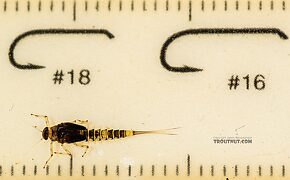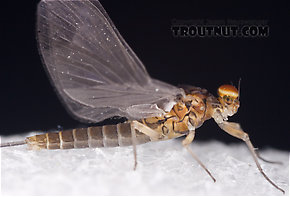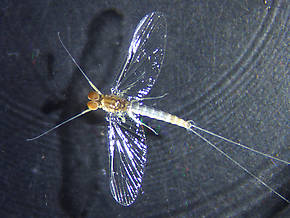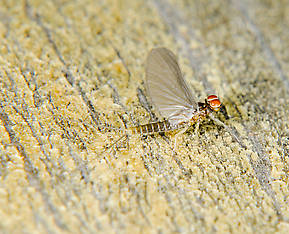Blog & Latest Updates
Fly Fishing Articles
Insects by Common Name


Light Blue Duns
This common name refers to only one species.
Mayfly Species Baetis tricaudatus
These are very rarely called Light Blue Duns.
Baetis tricaudatus is undeniably the most widespread and abundant baetid on the continent and arguably the most important mayfly species to trout and anglers alike. Eastern anglers used to know these important mayflies by the storied name of Baetis vagans. Conversely, the usually much larger and late Fall hatching brood of Baetis tricaudatus was considered an important Western species with its own tradition. But, entomologists recently determined that they are both in fact the same species. The nomenclature conventions guiding entomologists do not account for a name's regional fame among fishermen, and new or obscure species names may replace their old favorites. Sometimes taxa with disparate traditions are combined. Baetis vagans is one such casualty. Fortunately, trout think like Shakespeare: A rose by any other name would smell as sweet. The rose that was vagans has lost none of its charm. This species is multibrooded (Multibrooded: Producing more than one generation in a single year. Baetis mayflies are a classic example. Insects which produce a single generation with two distinct peaks (like the June and September hatches of Isonychia bicolor mayflies) are not multibrooded, because the fall insects are offspring from the previous fall instead of the current year's spring.) with the hatches of Spring being larger flies. As the weather warms the following broods are composed of progressively smaller flies. In the East, they range in size from 16 to 20. In the West, they may run a size larger.
Male Baetis tricaudatus (Blue-Winged Olive) Mayfly Nymph View 14 PicturesThis specimen and many like it were found with other specimens I found to be duller-colored females of the same species. I wasn't aware of such a difference between male and female nymphs in Baetids, but all the morphological characteristics I checked in the key were the same, and the color patterns are, too -- just not the brightness.
View 14 PicturesThis specimen and many like it were found with other specimens I found to be duller-colored females of the same species. I wasn't aware of such a difference between male and female nymphs in Baetids, but all the morphological characteristics I checked in the key were the same, and the color patterns are, too -- just not the brightness.
 View 14 PicturesThis specimen and many like it were found with other specimens I found to be duller-colored females of the same species. I wasn't aware of such a difference between male and female nymphs in Baetids, but all the morphological characteristics I checked in the key were the same, and the color patterns are, too -- just not the brightness.
View 14 PicturesThis specimen and many like it were found with other specimens I found to be duller-colored females of the same species. I wasn't aware of such a difference between male and female nymphs in Baetids, but all the morphological characteristics I checked in the key were the same, and the color patterns are, too -- just not the brightness.Male Baetis tricaudatus (Blue-Winged Olive) Mayfly Dun View 8 PicturesThis male was associated with a female of the same species.
View 8 PicturesThis male was associated with a female of the same species.
 View 8 PicturesThis male was associated with a female of the same species.
View 8 PicturesThis male was associated with a female of the same species.See 8 more specimens...
Top 10 Fly Hatches
Top Gift Shop Designs
Eat mayflies.
Top Insect Specimens
Miscellaneous Sites
Troutnut.com is copyright © 2004-2024 Jason
Neuswanger (email Jason). See my FAQ for information about use of my images.
 privacy policy
privacy policy


